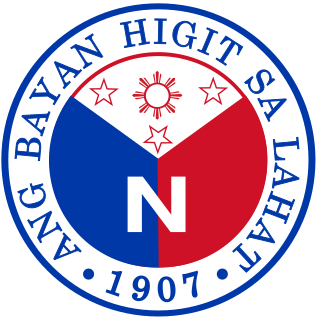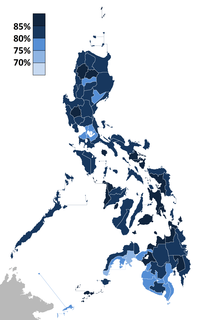
The President of the Philippines is the head of state and head of government of the Philippines. The President leads the executive branch of the Philippine government and is the commander-in-chief of the Armed Forces of the Philippines. The President is directly elected by the people, and is one of only two nationally elected executive officials, the other being the Vice President of the Philippines. However, four vice presidents have assumed the presidency without having been elected to the office, by virtue of a president's intra-term death or resignation.

The Liberal Party of the Philippines or LP is a liberal political party in the Philippines, founded by then senators Senate President Manuel Roxas, Senate President Pro-Tempore Elpidio Quirino, and former 9th Senatorial District Senator José Avelino, on January 19, 1946 by a breakaway Liberal wing from the old Nacionalista Party. It was the ruling party from 2010 to 2016 after the election victory of Benigno Aquino III as the President of the Philippines. Today, the Liberals are the opposition and maintain at least five seats in the Senate, and at least 41 of seats in the House of Representatives. Around 50% of governors, 50% of vice governors, and 33% of board members are also Liberals.

Carlos Polestico Garcia was a Filipino teacher, poet, orator, lawyer, public official, political economist, organized guerrilla and Commonwealth military leader, who was the eighth President of the Philippines.
The Cabinet of the Philippines consists of the heads of the largest part of the executive branch of the national government of the Philippines. Currently, it includes the secretaries of 20 executive departments and the heads of other several other minor agencies and offices that are subordinate to the President of the Philippines.

Philippine elections are of several types. The president, vice-president, and the senators are elected for a six-year term, while the members of the House of Representatives, governors, vice-governors, members of the Sangguniang Panlalawigan, mayors, vice-mayors, members of the Sangguniang Panlungsod/members of the Sangguniang Bayan, barangay officials, and the members of the Sangguniang Kabataan are elected to serve for a three-year term.

The Government of the Philippines is the national government of the Philippines. It is governed as unitary state under a presidential representative and democratic and a constitutional republic where the President function as both the head of state and the head of government of the country within a pluriform multi-party system.

The Nacionalista Party is the oldest political party in the Philippines and in Southeast Asia responsible for leading the country throughout the majority of the 20th century since its founding in 1907, being the ruling party from 1935 to 1944, 1944–1946, 1953–1957, 1957–1961 and 1965–1972.
The University of Santo Tomas Graduate School is the graduate school of the University of Santo Tomas, the oldest and largest Catholic university in Manila, Philippines.

Presidential, legislative and local elections were held on November 11, 1969 in the Philippines. Incumbent President Ferdinand Marcos won an unprecedented second full term as President of the Philippines. Marcos was the last president in the entire electoral history who ran for and won a second term. His running mate, incumbent Vice President Fernando Lopez was also elected to a third full term as Vice President of the Philippines. An unprecedented twelve candidates ran for president, however ten of those were nuisance candidates.

Presidential, legislative and local elections were held on November 9, 1965, in the Philippines. Incumbent President Diosdado Macapagal lost his opportunity to get a second full term as President of the Philippines to Senate President Ferdinand Marcos. His running mate, Senator Gerardo Roxas lost to former Vice President Fernando Lopez. Emmanuel Pelaez did not run for vice president. An unprecedented twelve candidates ran for president; however, nine of those were nuisance candidates.

Presidential, legislative and local elections were held on November 14, 1961 in the Philippines. Incumbent President Carlos P. Garcia lost his opportunity for a second full term as President of the Philippines to Vice President President Diosdado Macapagal. His running mate, Senator Gil J. Puyat lost to Senator Emmanuel Pelaez. Six candidates ran for president, four of whom were "nuisance" candidates. This was the only election in Philippine electoral history in which a vice-president defeated the incumbent president.
Presidential, legislative and local elections were held on November 11, 1969 in the Philippines. Incumbent President Ferdinand Marcos won an unprecedented second full term as President of the Philippines. Marcos was the last president in the entire electoral history who ran and won for a second term. His running mate, incumbent Vice President Fernando Lopez was also elected to a third full term as Vice President of the Philippines. An unprecedented twelve candidates ran for president, however ten of those were nuisance candidates.
Presidential elections, legislative elections and local elections were held in the Philippines on May 11, 1998. In the presidential election, Vice President Joseph Estrada won a six-year term as President by a landslide victory. In the vice-presidential race, Senator Gloria Macapagal-Arroyo won a six-year term as Vice President also by a landslide victory. This was the third election where both president and vice president came from different parties.

A general election in the Philippines took place on May 9, 2016, for executive and legislative branches for all levels of government – national, provincial, and local, except for the barangay officials.
The 2019 Philippine general election will be conducted on May 13, 2019. It shall be a midterm election, where the winners will take office on June 30, 2019, midway the term of President Rodrigo Duterte.

The President of the United Nations Economic and Social Council is the presiding officer of that body.
















